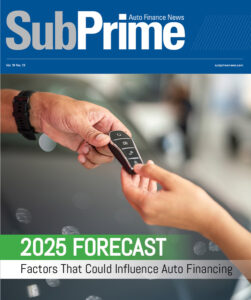Auto defaults remain stable, as credit availability tightens

Following a month when the auto default rate remained steady, credit availability for new paper tightened. Those findings are among the latest observations from Cox Automotive, S&P Dow Jones Indices and Experian.
Based on data through November for the S&P/Experian Consumer Credit Default Indices, the auto default rate remained unchanged at 0.77%.
The November reading also still is 12 basis points below the mark analysts noted in February 2020, which was the last one before the pandemic arrived.
S&P Dow Jones Indices and Experian indicated the composite rate — a comprehensive measure of changes in consumer credit defaults — ticked up 2 basis points in November to 0.59%.
Analysts said the bank card default rate rose 16 basis points higher to 2.62%, while the first mortgage default rate edged up 1 basis point to 0.42%.
Looking at the five major metropolitan areas S&P Dow Jones Indices and Experian track each month, analyst discovered Chicago posted the largest sequential increase in November, rising 8 basis points to 0.71%. New York climbed 6 basis points to 0.66% while Los Angeles was unchanged at 0.36%.
Analysts found that Dallas’ default rate dropped 6 basis points in November to 0.58% as Miami fell by 11 basis points to 0.70%.
Meanwhile, it was a little more difficult for dealerships to get their contracts bought during the closing month of 2022.
Access to auto credit tightened again in December, according to the Dealertrack Credit Availability Index for all types of auto financing. Cox Automotive reported the index declined 2.1% to 99.1 in December, reflecting that auto credit was harder to get in the month compared to November.
Experts said in a Data Point posted on Tuesday that the decline in access reflected conditions that were tightest since September.
With the decline in December, Cox Automotive noted that access was tighter by 2.5% year-over-year. And compared to February 2020, experts said access was tighter by 0.1%.
“Most credit availability factors moved against consumers in December, as yield spreads widened, the subprime share declined, terms shortened, the share of loans with negative equity declined, and down payments increased,” Cox Automotive said.
“The average yield spread on auto loans widened, so rates consumers saw on auto loans were less attractive in December relative to bond yields,” analysts continued. “The average auto loan rate increased by 7 basis points in December compared to November, while the 5-year U.S. Treasury declined by 27 basis points, resulting in a wider average observed yield spread.
“The one factor with positive movement for consumers in December was a small increase in the approval rate,” Cox Automotive added.
Analysts went on to mention that the subprime share declined to 11.0% in December from 11.5% in November and was down 0.8 percentage points year-over-year.
The approval rate increased 0.5 percentage points in November but was down 3.1 percentage points year-over-year.
“Those were the biggest changes over the last year in addition to the rate changes,” Cox Automotive said.
Each Dealertrack Auto Credit Index tracks shifts in contract approval rates, subprime share, yield spreads and loan details including term length, negative equity and down payments. The index is baselined to January 2019 to provide a view of how credit access shifts over time.

 View The Latest Edition
View The Latest Edition

